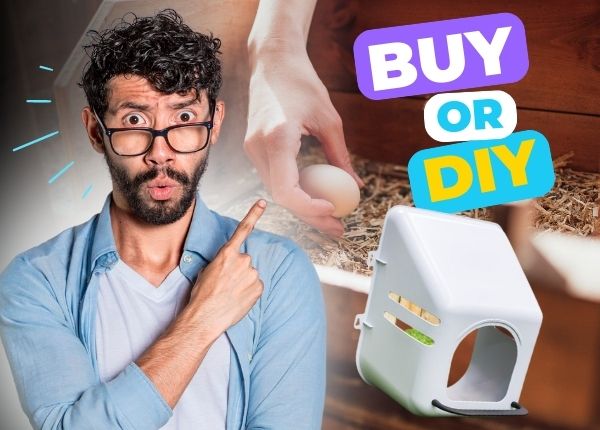
Easter egg hunts are so much fun! But egg hunts are for Easter and not the other 364 days of the year. The fun soon wears off when you’re late for work because you were crawling behind the shed trying to find your breakfast!
Nesting boxes are often thought of as essential birdy bedrooms, but whatever your hen tries to tell you, they’re not for sleeping in.
Nesting boxes aren’t an essential bit of kit from your chickens’ perspective. They’re there mainly for your sanity, but they also have a lot of perks for your poultry pals!
Your hens have no expectations as to where they’ll lay their eggs🥚 and will scatter their wares about in corners of outhouses, behind the car wheel, or in an abandoned slipper. There’s no guessing where Geraldine will reverse up and relieve herself!
Nesting boxes were designed for happy humans rather than happy hens - though even the most reluctant residents usually learn to love them and can get rather possessive of their favorite pop spots!
Please don't confuse my comment that nesting boxes aren't essential with them not being the best thing since sliced bread! Your hen might not have had this level of luxury in the wild or expect it in your yard...but this isn't the jungle, its home, and if you want the best for your buddies then a nesting box it is!
An anxious hen will not lay as reliably and a nesting box will give her somewhere safe, private, cozy, and draft free to lay her yummy eggs. A relaxed environment will mean a happy hen and that means more eggs for you.
If you want your broody Momma to sit and raise some baby chicks🐣 for you, then a nice nesting box is the very least you can do to help her out. She won't mind at all if you buy it or DIY it, as long as the bedding is dry and clean.
The reason to invest in this bit of chicken kit is to make your hens happy and keep them laying optimally, and also so that you can find your eggs easily, in one piece, and before predators get to them.
Let’s take a beak at how many boxes you need, how big they need to be, your store-bought options, and some DIY designs.
- Do Hens Have to Have Nesting Boxes?
- When Should I Introduce Nesting Boxes?
- Picking the Right Nesting Box for Your Hens
- What Size Nesting Box Does My Chicken Need?
- How Many Nesting Boxes Do I Need?
- Wooden Nesting Boxes
- Metal Nesting Boxes
- Plastic Nesting Boxes
- Nesting Box Design Basics
- What’s a Rollaway Nesting Box?
- Positioning Nesting Boxes
- Do I Need to Elevate My Chickens’ Nesting Box?
- How High Off the Ground Should My Nesting Box Be?
- What Should I Put in My Chicken’s Nesting Box?
- Why Won’t My Chicken Use Her Nesting Box?
- Training Hens to Use a Nesting Box
- Is It Okay for My Hens To Share A Nesting Box?
- Why Are My Hens Fighting Over Nesting Boxes?
- Why Is My Hen Roosting in Her Nesting Box?
- Why Won’t My Hen Leave Her Eggs?
- DIY Nesting Boxes
ARE NESTING BOXES NECESSARY?
Do Hens Have to Have Nesting Boxes?
You don’t have to have nesting boxes for your chickens, but they will make life easier for everyone.
If you only have retired layers or roosters🐓, then you won’t need nesting boxes. They’re not to be confused with bedrooms. They’re for laying eggs in and nothing more.
Laying hens can cope just fine without nesting boxes. Some hens refuse to use them anyway, favoring some weird and wonderful crevice they’ve discovered on their daily explorations.
Chickens like to lay their eggs somewhere private, dark, draft-free and quiet.
Somewhere they feel safe.
Free-ranging hens or those who have access to lots of cozy corners will be quite happy to go without a nesting box, but their eggs might get trampled, dirty, lost, or carried off by a Coyote. Plus, if you want ‘em, you’ll have to find ‘em first!
When Should I Introduce Nesting Boxes?
You’ll need to have your nesting boxes available ready for your little girl’s first egg! If your baby chicks are growing up fast, then it’s time to prepare. They do grow up so quickly!
When your pullets are 16-20 weeks, they’ll be ready to lay. They’ll have a change in their behavior and look a bit more anxious, on edge, and be exploring dark corners instinctively seeking a nesting spot. This is when you should introduce their nesting box.
WHICH NESTING BOX IS BEST?
Picking the Right Nesting Box for Your Hens
There are five factors to consider when you choose, or design, your nesting boxes:
- Size How big does each box need to be?
- Quantity How many will you need?
- Location Where to place your nesting boxes?
- Material What material will work best for you?
- Design What’s a good nesting box design, and what’s not?
What Size Nesting Box Does My Chicken Need?
The size of your nesting box depends on the size of your hen. Larger hens need larger boxes.
You might be tempted to future-proof your coop and get the biggest nesting box you can find, but nesting boxes need to be a snug fit.
Boxes that are too big don’t feel secure for hens, so they might not get used. If they do use them but have too much space to hang out in there and mess up their room, then they will.
Double bunking – where two hens squeeze in together – looks adorable but is an accident waiting to happen. Four feet, two bottoms, one fragile egg – you can guess the rest.
Most standard-sized nesting boxes are 12-inches cubed. These are suited to standard-sized chicken breeds like Plymouth Rocks, Leghorns, or Sussexes.
Larger nesting boxes are available from 14-inches wide and will be a better fit for a larger lady like a Jersey Giant and Brahmas.

You can buy smaller nesting boxes too, which tend to be around 10-inches wide, and will be just right for smaller breeds and bantams.
Make your nesting box yourself, and it can be whatever size your heart desires.
How Many Nesting Boxes Do I Need?
Most chicken keepers agree that one nesting box for every 3 hens is more realistic. This is because they share nesting boxes and they don’t all lay at the same time. They work it out, you don’t need to get involved, just be patient (it’s worth the wait;) )
It can be confusing when people say hens should share a nesting box, but you shouldn’t have more than one hen in a nesting box at the same time. The idea of having 3 hens per nesting box assumes that your ladies will take turns in a lady-like manor.
WHICH NESTING BOX TO BUY?
Wooden Nesting Boxes

Wooden nesting boxes are the most traditional-looking nesting boxes and are very sturdy which is great for larger chicken breeds.
Wood is heavy though, so when you add a big-bootied bird to it, you’ll need a strong coop wall if you’re looking to mount them. Lots of people choose to have floor-standing wooden nesting boxes because of their weight.
Wood does retain moisture and can rot if not appropriately prepared, so you’ll need to keep on top of your cleaning routine and maintain a decent layer of bedding to absorb accidental scrambles.
Pros: Easy to DIY, good for hot and cold climates
Cons: Need a base layer keep bedding directly off timber for longevity
Metal Nesting Boxes
Metal nesting boxes are strong and light, so they’re brilliant if you need multiple nesting boxes without the weight. They’ll come with pre-drilled holes to make them easy to mount, and they’re treated to ensure no sharp edges or rust.
Conventional, wooden nesting boxes are sold singly, but the majority of metal nesting boxes come in multiples.
They aren’t as country-cottage looking as wooden nesting boxes, but this industrial chic option is practical and affordable.
Pros: Light weight
Cons: Can be very hot in summer and must be well layered with bedding at all times to ensure comfort and consistent temperature
Plastic Nesting Boxes
Plastic nesting boxes are the cheapest ones on the market. They have a lot going for them since they’re also easy to clean, sturdy, and lightweight.
They aren’t always suitable for bigger breeds though as they can buckle under excessive weight.
Pros: Light wight and cost effective if you need to buy a larger volume. Easy to install, easy to clean.
Cons: Can be on the small side.
Nesting Box Design Basics
As well as selecting the right size, number, and material of nesting box for your ladies, you should consider whether the design is fit for purpose before you buy. Here are a few things to think about:
Sloped roofs will stop hens from roosting (and pooping) on the top of their nesting boxes, meaning less cleaning for you, unless you make them externally accessible so they can only sit in them not on them.
A barrier at the front of the box will keep the bedding and the egg in, whilst your chicken can still get out easily. This should be at least an inch high.
What’s a Rollaway Nesting Box?
Rollaway nesting boxes are very clever as they have a slanted floor that rolls eggs safely away from hens as soon as they’re laid. This secures them from being trampled or pecked at and helps to keep eggs clean.
Leaving the bloom on your eggs will help your eggs last longer but keeping poopy eggs on the kitchen worktop doesn’t suit everyone. If you like clean eggs, then a rollaway would work well for you.
“Clean boxes mean clean eggs, and since it's best not to wash your eggs until just before using them, and manure or mud on the eggs can cause bacteria to seep into the eggs through the pores in the eggshell, keeping the eggs clean is important.” (Fresh Eggs Daily)
WHAT DO I HAVE TO DO WITH MY CHICKENS’ NESTING BOXES?
Positioning Nesting Boxes

The positioning of each nesting box should be somewhere:
- Quiet
- Safe
- Darkened
- Private
- Draft-free
If you miss a trick on any of these criteria, then little Sally, Sandra, and Susan might snub your efforts altogether and refuse to use their box.
Find a spot that’s not near common gathering spots like the feeder or waterer, not in direct sunlight, but also not the favorite shady spot which might get busy on a sunny day!
“Your boxes should be placed in a spot that is easy to access for cleaning and egg collection. By positioning the boxes in a darker spot, you can also create feelings of privacy and comfort, which will also encourage your girls to lay.” (Chickenpedia Coop Design Course)
Do I Need to Elevate My Chickens’ Nesting Box?
Nesting boxes are best elevated, since it helps chickens feel secure, protects eggs from predation, and will minimize the cold and damp. How much each nesting box should be elevated depends entirely on its customer.
How High Off the Ground Should My Nesting Box Be?
The height of a nesting box should be at least 18 inches from the floor and can be as high as a few feet off the ground depending on your hens.
Not all chickens can fly. If you have Silkies or Polish chickens which can’t fly at all, then they’ll need a ramp to get them to where they need to go. Don’t go building skyscrapers with access issues!
If you have heavier breeds like Jersey Giants, even if they do manage to reach an elevated nesting box, the hop back down could result in injury if they’re too high up.
Be careful not to mount your nesting boxes at the same level as your roost bars, else your chickens will be hopping from one to another and you’ll soon have very dirty nesting boxes, which cheeky chickens refuse to use (even though it’s their mess…but you know what they’re like!)
“The nesting boxes should always be a minimum of 1 foot (30cm) up off the ground. This is to keep them draft-free, but also to protect the chickens and their eggs from prying eyes (predators).” (Chickenpedia Coop Design Course)
What Should I Put in My Chicken’s Nesting Box?
Nesting boxes need to be comfortable and warm to entice your little layers in, and to cushion the eggs.
You can use a range of materials to line your nesting box, and some chickens might show a preference if you let them test out a few options. Hemp bedding has always been a favorite of mine, it’s a Natural pest repellent, controls odour, clumps for easy clean up and it's highly absorbent. Pine shavings are easy to get hold of, as is straw. If you’re short on storage space nesting pads are purpose-made pads that can be washed and reused.

⚠️HOT TIP: I do not recommend shredding paper, grass clippings, or wood shavings. All of these deteriorate quickly, paper and garden matter go mouldy and wood shavings are dusty which can cause respiratory issues for your hens.
TOP FIVE NESTING BOX PROBLEMS SOLVED
1. Why Won’t My Chicken Use Her Nesting Box?
If your hens are being stubborn and refuse to grace their shiny new nesting boxes with their presence, there will be a good reason why.
The box might be positioned in too busy or noisy a spot. Hens like their privacy when they deliver the goods.
Is the box the wrong size, or positioned too high for them to get to?
There is always the chance that they are desperate to use it but are taking great pleasure in winding you up. I’m only joking, but you do wonder sometimes, don’t you?
Training Hens to Use a Nesting Box
If you introduce pullets to a flock with laying hens they’ll soon follow their leader and use a nesting box to fit in with the crowd, but if they’re the first ladies in the land, then they might need a nudge in the right direction.
A sign on the door won’t really work, but a fake egg, golf ball, or ping pong ball might give your hen a brilliant idea.
Just like potty training, it won’t happen overnight, but give them a little while and they’ll soon get the swing of it.
Some hens will need persuading to test out the nesting! If they need a little egg-stra persuasion to try something new, then keep them in their coop until they’ve laid their eggs. If they know it’s happening inside the coop one way or another, they’ll be more open to taking the best spot available.
2. Is It Okay for My Hens to Share A Nesting Box?
Hens are social when it comes to their morning routines. They like to be close to each other, and most would prefer to squeeze in alongside their neighbor than wait. If they’re happy, then it’s fine, but you are more likely to lose some eggs to damage.
If you find your hens are double bunking, try adding a divide to the nesting box, or using smaller boxes altogether. You can still place them alongside each other so the ladies can still have a natter, which they will.
3. Why Are My Hens Fighting Over Nesting Boxes?
If you have the opposite problem to double-bunking, and your girls are incapable of sharing nicely without breaking out in a scrap, then take away their iPads for a week.
Sorry, I do confuse hens and nesting boxes with kids and bathrooms sometimes: so many similarities!
For a start, they will always need to use the facilities at precisely the same moment in time. If you have fewer boxes than birds and your hens typically seem to need to lay at the same time, then you might need to invest in more boxes.
Just like kids though, they will still HAVE to use the same one, no matter how many facilities you have.
If there seems to be one coveted box that everyone wants, try to replicate its characteristics with the other boxes. It might be the position, bedding, or style that they prefer.
4. Why Is My Hen Roosting in Her Nesting Box?
Chickens can appreciate the security of their nesting boxes a little too much. If your chicken is spending too much time roosting in the box, not sharing, and making a mess of it, then you’ll need to coax her out.
Try sealing off your nesting boxes after morning eggs have been laid.
Bear in mind that hiding away might be a sign of bullying from other birds, or lethargy because of illness. Keep an eye on her if she’s distressed when you insist she gets some exercise.
5. Why Won’t My Hen Leave Her Eggs?
If your hen is refusing to leave her nesting box because she’s sitting, then you have a broody momma.
Sadly, there is no way to tackle this other than removing the eggs or the hen from the equation. Whatever you pick, wear gloves.
You can coax mommy out of the nesting box by making it undesirable. Add icy water bottles to the box, remove the cozy bedding, or add light or noise to the area.
The health of your broody Momma in during this time is critical. She will stop eating and drinking to ensure her eggs are kept safe and at a consistent temperature instinctively and this can g on for weeks. You need to show some tough love and take her off the nest promptly and lock her out of the coop, or away from the nesting boxes and ensure she gets water and food. In my experience, a few rounds of this will do the trick.
DIY NESTING BOXES
DIY nesting boxes are brilliant! They’re the cheapest option, maybe even free, and totally in tune with sustainability and recycling. Using household containers and items that would usually go to waste will reduce your carbon footprint and increase your bank balance. Double winner!

The options are endless. So long as you have the key design features mentioned earlier in mind, and you make sure that there are no sharp edges, dangerous paints or chemicals, or risks of collapse, then go for it! Get your creative skills flowing and then let your ladies try out your handiwork.
Feel free to stick your beak into these DIY nesting box designs. Copy them, tweak, them or create something completely new.
Plastic tubs, recycling boxes, pre-loved wooden pallets, and apple crates are firm favorites, with bookshelves, old dressers, flat tires, and cat litter buckets all proving perfect nesting box material.
YOU CRAFTY THING, YOU!
SHARE YOUR DIY NESTING BOX DESIGNS WITH US!
The first rule of keeping chickens is to keep it simple! It’s hard to relish the rural way of chicken husbandry if you’re stressing over shopping for the perfect products.
If you’re not sure what you need to buy to prepare for and care for your new poultry pals, then shopping trips can soon get stressful and expensive.
Have a nosey at Chickenpedia. They offer fast, fun, down-to-Earth chicken-keeping advice. You can complete their online courses in under an hour, in your PJs, and will soon feel confident to prepare appropriately, and not egg-sessively!











Leave a comment (all fields required)